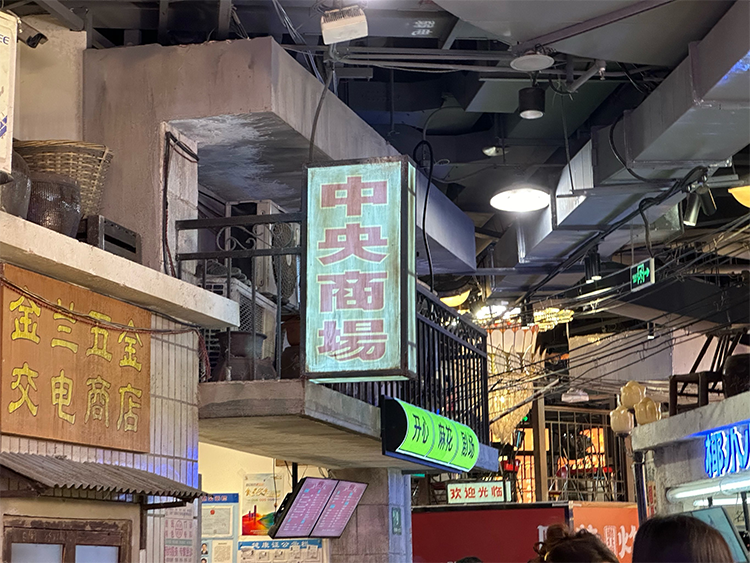North Bund 90s Food Alley: Discover Shanghai Food Nostalgia
North Bund 90s Shanghai Food Alley
Introduction
Step into a time capsule beneath Raffles City North Bund: an indoor, Instagram-ready food alley that recreates 1990s Shanghai alleyways. With weathered walls, vintage bicycles, neon signs and old-school posters, the market pairs nostalgic atmosphere with classic Shanghai snacks—perfect for curious food lovers and culture seekers.
1. Core Highlights and Unique Selling Point
This is a fully immersive 90s-themed food market inside Raffles City North Bund (B2), blending authentic Shanghai street flavors with a staged, retro lilong (lane) setting. It’s both a local-feel food court and a social-media hotspot—historic brand names meet trendy photo corners.

2. Local Culture and Nightlife Vibe
Although indoors and not a traditional open-air night market, the venue channels Shanghai’s evening energy. Locals come to unwind after work, chat over small plates, and relive old neighborhood memories. The lighting turns warmer after dusk, neon signs and jingling bicycle bells give it a laid-back, friendly nightlife atmosphere unlike the city’s glossier bars.
3. Main Foods and Signature Snacks (5–8 must-try items)
– Tilanqiao Scallion Pancake (提篮桥葱油饼): Crispy layers, fragrant scallions and slightly oily crunch—an ideal on-the-go snack.
– Shengjian and Fried Buns: Golden, pan-fried dumplings with juicy filling—crispy bottom, soft top.
– Classic Pastries (沈大成): Traditional Shanghai pastries and steamed cakes—sweet, flaky, neat for tea-time.
– Tangyuan from Qibao Old Street (七宝老街汤圆): Sweet glutinous rice balls served warm in syrup—comforting and nostalgic.
– Savory Sparerib Rice Cake or Sticky Rice Snacks (鲜得来-style): Hearty, local flavors often featuring soy and savory-sweet notes.
– Shaoxing-style Small Dishes (小绍兴): Mildly spiced braised dishes and small plates good for sharing.
– Local Tea and Soft Drinks (大壶春 and similar): Try traditional tea or bottled old-school drinks for a full retro pairing.
These items showcase Shanghai’s preference for balance—light sweetness, umami-savory touches, and textures that range from flaky to chewy.

4. Environment and Crowd Profile
Expect a mixed crowd: local families, young couples, office workers, and tourists hunting for authentic tastes and photo angles. The alleyways are intentionally narrow to mimic old shikumen lanes. You’ll notice patched plaster, communal payphones (as decor), neon shop signs, and clustered stools—creating a cozy, slightly bustling vibe. Evenings are livelier; daytime is gentler and better for relaxed exploration.
5. Suggested Visit Plan
– Time to allocate: 1.5–2.5 hours to stroll, sample 4–6 snacks, and take photos.
– Best timing: Arrive late afternoon or early evening (5–8pm) to capture both daylight and neon ambiance while avoiding the heaviest crowds.
– Combination ideas: Pair your visit with a North Bund riverside walk, a Bund skyline view at sunset, or a short trip to nearby historical sites in Hongkou.

6. Practical Tips (How to eat, pay, and avoid queues)
– Queues: Popular stalls can have short lines around dinner—weekday early evenings or late afternoons reduce wait time.
– Ordering & Language: Menus often have English or picture prompts; simple Mandarin phrases (e.g., “yī fèn” for one portion) help. Staff are usually used to tourists—pointing at the display works fine.
– Payment: Most vendors accept mobile payment (WeChat Pay/Alipay) and UnionPay. Some smaller stalls may prefer cash—carry a small amount of RMB. If you rely on foreign cards, larger counters within the complex usually accept them.
– Hygiene and Comfort: High turnover keeps food fresh; peak hours are busiest so choose stalls with visible cooking. Restroom facilities are available in the mall.
7. Local Insights & Hidden Gems
– Hidden treats: Seek smaller counters off the main lane for regional specialties—less-promoted stalls often use family recipes.
– Photo spots: Look for a weathered blue bicycle leaning against a cracked wall, vintage payphone booth, or neon “90s” sign—perfect for shots.
– Avoiding tourist traps: If something seems overpriced compared to others, check portion size or ingredients. Local favorites usually have consistent crowds and steady turnover.
– Ask for recommendations: Stall vendors are happy to suggest their bestsellers; asking for “tèsè” (specialty) usually points you in the right direction.

8. Essential Practical Info
– Name: Raffles City North Bund Lilong City Market (B2, North Bund Raffles City, Hongkou).
– Opening hours: 10:00–22:00 daily.
– Budget: Expect a wide range—individual snacks typically 10–40 CNY; a full snack meal with a drink around 40–120 CNY per person depending on choices.
– How to get there: Metro Line 12 to Tilanqiao Station (direct access to the mall). Taxis and ride-hailing are also convenient.
– Accessibility: Being inside a modern mall, elevators and accessible restrooms are available, but some alley-styled areas are narrow.
Conclusion: Why Add It to Your Shanghai Itinerary?
Raffles City North Bund’s 90s-themed food alley offers a quick, sensory-rich dive into Shanghai’s everyday food culture—nostalgic yet polished, with flavors rooted in local tradition. Whether you’re chasing authentic little eats, unique photos, or a mellow evening spot where locals unwind, this indoor market packs vintage atmosphere and genuine taste into one easy stop. Add 1–2 hours to your day here, combine with nearby Bund sights, and you’ll leave with both a full stomach and a new appreciation for Shanghai’s layered past.

Practical recap
10:00–22:00, B2 Raffles City North Bund, metro Line 12 Tilanqiao Station—bring some cash, arrive off-peak if you hate lines, and don’t forget your camera.


